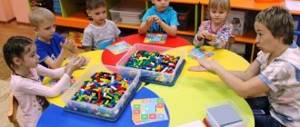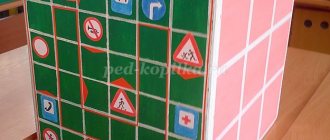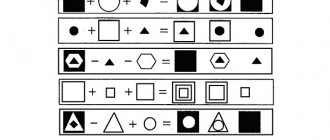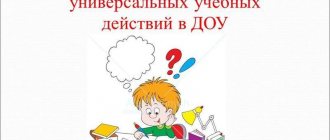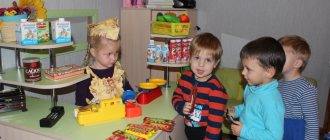The importance of the art corner in kindergarten
Most preschoolers love to draw. They really like art classes in kindergarten, and therefore, in their free time, the children are happy to repeat their drawings and crafts. Many people like to color ready-made pictures, for example, on a certain theme (for girls - fairy-tale princesses, and for boys - cars, planes, etc.). Some people are interested in looking at albums with reproductions of paintings and elegant folk crafts (matryoshka dolls, wooden spoons, dishes, trays).
Many children in kindergarten enjoy coloring pictures in their free time.
All of these types of activities contribute to the creative development of preschoolers, and the child will be able to find a suitable activity in the art corner, which the teacher will equip specifically for this purpose. Children get the opportunity to reveal their potential and enrich their understanding of the beauty of the world around them.
The fine arts area is also designed for parents in the locker room in the form of a beautiful stand. After all, it is very interesting for mothers and fathers to see the drawings and crafts that their children have created with their own hands. This gives adults the opportunity to get in touch with the educational process in a preschool educational institution.
Parents enjoy looking at their children's drawings and crafts.
Fine arts in kindergarten
Psychology of children's creativity
(methodological recommendations for beginning teachers)
Author: teacher of special disciplines at MBU DO “Children's Art School No. 1”, Ryazan Baukova I.P. Description: Art shapes and develops a person in many ways and influences his inner world. It develops the eye and fingers, deepens and directs emotions, excites imagination, and makes thought work. This article is part of the work program on fine arts at a children's art studio, based on personal teaching experience. Provides useful information on the main artistic disciplines (drawing, painting, composition, creative arts). Designed for children of preschool and primary school age. Goal: to develop in art classes the sense of beauty given to children by nature. Combining the game and the alphabet will allow them to understand that the field of fine art is both interesting and not easy. For the fullest development of children's abilities, it is recommended to use a variety of materials and techniques in the classroom. Objectives: 1. Enrichment of artistic horizons through knowledge about fine and decorative arts and their role in human life; 2. The need to develop children’s knowledge, skills and abilities in the field of fine arts. It's never too late to learn to draw, but we must agree that the basics of fine art are best learned at an early age.
According to Dahl, to create is to give being, to create, to create, to produce, to give birth. This is an active property. Humanity is generously endowed with it, and children in particular. When a child enters an art school, he or she already knows, to some extent, visual means of expression, but does not yet realize their systematic nature. The use of these drugs by a child is in the nature of a game. V. Favorsky wrote: “It would be extremely joyful if it were possible to transfer children’s creativity, without breaking or tearing it off, but also without preserving it, but gradually complicating it, into the creativity of adults, without losing the wealth won by the child, and this is apparently possible ."
Late learning of mastery is a serious obstacle to creativity. The teacher must exercise the greatest restraint in influencing students. Because even a teacher who has taste and inclinations can fix a child in a spectacular but primitive way of drawing, can instill in him the premature “academicism” of an adult. By turning away from his own tasks, he thus loses the most valuable thing - independence.
“From play to knowledge” is the motto of the program for young children. This is how a child works, he learns everything through play, through the creation of a second reality - text, drawing, sculpture. While playing, a miracle is revealed to him - whatever you think of, you can draw, glue, sculpt, etc. Children constantly invent something and fantasize. Their ability to animate the inanimate world with their imagination dictates the teacher’s teaching methods. But we must remember that each child is a separate world. At the heart of a child’s consciousness is an image, complex, but very integral. The teacher’s task is to expand the child’s understanding of ways to achieve a goal, to reveal to him the variety of methods and means that are gradually given to him in the game.
To experience, to realize, to be able to do so are the three stages of the creative process. What has not been experienced and not felt emotionally cannot be embodied. Therefore, the uniqueness of each child and his experience are the starting point for creative search. Independent choice of solving a creative problem makes a child courageous, sincere, he develops imagination and intelligence, the gift of an observer; patience and taste are formed. All this provides a path to beauty. The experienced beauty drives the child in search of the most expressive means of its embodiment. Failures in this case are even useful.
At the initial stage of learning, children complete all drawing, painting and composition tasks with equal interest. They are fascinated by new techniques and techniques; For them, many things are new and unusual. The level of skill, thinking and artistic expression actually coincide. Hence the passion. Composition carries within itself a creative beginning, and without active work in this area one cannot talk about educating an artist. Therefore, it is a core subject in primary school. The teacher’s task is to help the child express his attitude to the world around him and convey his plans. The themes of elementary school compositions are often fairy-tale-fantastic in nature. Thematic lessons are usually preceded by conversations with illustrations. Moreover, stories, reading, poetry, listening to music should not be long in time, but emotional. Sometimes children at this moment must imagine something they have never seen. Literary works, music and visuals organize the child’s thinking and help him find the simplest and most expressive way of depicting. Thanks to this, over time, laconicism and ri class=”aligncenter” width=”625″ height=”441″|fcw3qayjh5a| src=»https://kladraz.ru/upload/blogs2/2016/4/13169_1fee343596ecd7473c312d95df54be8f.jpg» class=»aligncenter» width=»530″ height=»356″[/img] From work experience it is known that, listening fairy tale, children experience the events taking place in it, reflect the poetics of the magical atmosphere. This is expressed both in color and in line, plastic, architectonics and compositional solutions. Most often, children combine expressive means. The ability to “grab” what is heard and seen and convey it completely and directly is one of the main features of children's art. The teacher’s task is not to overload children with attention, giving them the opportunity to express themselves. Children's compositions can be cheerful and gloomy, joyful and strict, restless and calm, stately and simple. This variety depends not only on the theme and content, but also on the tonality of the colors, combinations of light and dark spots and many other points.
Children's works are filled with energy and pure emotions. Their creativity is bold and naive. Rhythm - consistency of shapes and colors. Composition, as the most powerful means of expressing an idea, includes all components of form: color, rhythm, pattern, movement, and determines the position of figures and objects in space. The method of rhythmic exercises makes the artist himself inspired, and his hand flexible, gives an impetus to further creativity - children concentrate, tune in to further work, full of fun and imagination. Symmetry is one of the compositional techniques. It is used more in decorative arts. Symmetrical compositions create a state of peace and solemn majesty.
In graphics and painting, balance is of great importance. Distribution of the load on the right and left, above and below, which allows you to create a balanced composition.
Children love to depict birds and animals. By drawing their attention to the habits, grace, beauty and plasticity of animals, we educate them, first of all, to be a kind and merciful person. But every artist should be able to draw a horse, cow, dog, cat. They will be useful in any genre. Only constant and purposeful study of animals with a pencil in hand will bring freedom in drawing, freedom in composition. But we must remember that by acquiring knowledge and studying nature and animals, the child becomes more confident in creating his own idea, acquires patience and perseverance, gains freedom in drawing, freedom in composition. Over time, the works will become more elaborate, but also more “personal”.
The artistic image of a child’s work will help create a whole system of techniques and means of expression, which can be called its language. Of great importance in this are: line, silhouette, tonal gradations and color combinations. Children need to be constantly reminded that the same motive can be solved in different ways and they themselves must take part in choosing the right technique to solve a particular problem. The work of students in a group is of great importance, where children are infected with ideas from each other, where there is a spirit of competition and the opportunity to influence each other.
At the initial stage of training, technically faster image methods are used, without careful elaboration. Children enjoy working with materials such as pastels and colored pencils.
By creating a lot of sketches, sketches, and exercises, they give children the opportunity to make choices. Drawing classes do not aim to make artists out of all children, but it is important to free up and more fully use such sources of children's energy as creativity, independence, awaken imagination, and strengthen nature's abilities to observe and evaluate reality. After all, in order to create something good, you must be able to admire and be surprised by it. The teacher should be motivated only by the desire to help and teach. By drawing, children better remember visible forms, reproduce their ideas about the reality around us, and develop and strengthen visual memory. A drawing can tell, show, explain this or that phenomenon, which makes it an important means of self-expression. The importance of materials is very high. Wide and thin lines, contour - this is the most flexible means when drawing, when placing objects in space, when determining scales, etc. The variety of shades in shading with pencil and other materials gives unique texture qualities. Children are visionaries and dreamers. They are always happy in creativity.
How sometimes you want to create! With the help of paints and a brush you can create a real masterpiece. How joyful and easy it is! Feel like artists. After all, there is nothing more beautiful in the world than creativity! Children are the most talented and most interesting artists in the world.
Painting is not only art, but also a necessary means of education. This is an opportunity to convey the beauty of the world around us, our emotions, and feelings through color. This is another way to convey some information. And, finally, this is a fascinating activity, all the wisdom of which can be learned.
Getting to know different techniques and materials will help you discover the magical world of painting. Gouache is soft and calm, watercolor is airy, but at the same time bright and deep, pastel is gentle and spontaneous... These painting materials have long been loved by both professionals and beginning artists. For children, these are tools that help transform reality into an image, and comprehend the complex laws of painting (such as form and space).
Familiarity with the basics of color science makes it possible to confidently mix paints and apply lively strokes to paper. Working with paints is very interesting because it contains an element of improvisation.
Step by step, children learn what color and coloring are.
Over time, they will develop their own creative style. The learning process can begin at almost any age. This requires coordination of all disciplines in the learning process, which will help move towards the main goal, which is the formation of imaginative thinking in children, as well as the combination of children's play and a rational approach based on professional knowledge. “Art is immutable, but learning to paint must begin from infancy” - JJ Rousseau
We recommend watching:
Unconventional drawing techniques in kindergarten. Winter patterns Drawing Baikal seal. Master class for children 5-8 years old step by step with photos Drawing a bear step by step for children from 5 years old How to draw a watermelon with a pencil step by step with photos for children
Similar articles:
Drawing lesson for children 3-5 years old using geometric shapes
Drawing games for preschoolers 3-5 years old
Consultations for parents in kindergarten. Visual activities
Requirements for the creation and design of an art corner
According to the modern educational standard (FSES), the design of the fine art zone in a group must meet the following requirements.
- The corner is located in a well-lit place (near the window).
- The equipment meets the needs of this age. After all, each age category is unique. For example, younger preschoolers are in the process of adaptation, so the teacher does not need to change the design often. Children's attention should not be distracted by unnecessary details. In addition, the iso corner should contribute to the development of children's sensory skills. At an older age, conditions for self-expression are more important.
- Materials for creativity and aesthetic development (for example, picture albums) should be freely available to preschoolers so that they feel like “masters” in the group.
- High aesthetics. A good corner attracts children's attention with its beautiful design. The guys should feel comfortable there and experience aesthetic pleasure. “Children’s” design is important - the inclusion of game characters (pictures and dolls) and creative works of students in the design.
- Multifunctionality. The gaming environment can be modified depending on the learning situation and combined with other zones. After all, groups are not very large rooms, so every meter must be used rationally. Equipment and materials must be easily transformed to create a new game. For example, with the help of the Fine Arts corner, you can organize a role-playing game “In the artist’s workshop” (combined with the theatrical corner).
- Variability. The equipment of the zone changes periodically: new material for creativity is added, children's demonstration works and design elements are updated. In addition, conditions should be created in the corner for individual (for example, drawing, modeling, coloring pictures) and collective activities (looking at albums, didactic games).
- Safety and high quality of materials used in creating the zone. This applies to both furniture and means for directly equipping the corner (for example, scissors and glue should be stored in boxes with a lid).
- Compliance with the gender principle. As you know, boys and girls have their own preferences. The teacher should take this point into account when selecting material in the art corner (in particular, offer coloring pages with cars, airplanes, robots and princesses, flowers, butterflies, etc.).
In early preschool age, the art zone can be combined with a sensory corner
For the art activity center (as well as for other zones in the group), the teacher draws up a passport, which indicates its name, purpose and details the equipment of the corner.
Federal State Educational Standards requirements for creation and design in preschool educational institutions
According to the requirements of the educational standard, an activity corner must be provided in a well-lit place. Furniture and materials must be of high quality. The content of the corner should correspond to the age of preschool children, and creative materials must be changed from time to time or supplemented with new ones.
The most optimal furniture for a corner is a cabinet with open shelves on which you can place inspiring items (albums, reproductions of paintings), and isolate the materials necessary for creativity (paper, glue, scissors) from children and store them in a closed bedside table or drawers. Or it could be a table combined with a shelving unit.
For your information! For organized storage of all necessary materials (cardboard, paints, plasticine), you can use boxes of different colors or plain ones with bright symbols of the contents.
To maintain a creative mood, you can add an easel, on which it is useful to mount a painting by a famous artist for inspiration or the best work done by the children.
Spiritual and moral education of a preschooler through fairy tales
For storing pencils, brushes, as well as natural (cones, shells, grain, etc.) and waste (buttons, sequins, beads, etc.) materials, plastic or tin glasses of the same size and bowls are suitable.
Contents of the ISO corner in the group
The most important component of the art zone in a group is its capacity. First of all, these are direct materials for creativity.
- Paper of various textures (matte, glossy, corrugated, velvet, transparent, self-adhesive film, cardboard) and format (A3, A4, A5), stickers, multi-colored foil.
- Paper tinted in warm and cool tones, two-color (blue top of the sheet is the sky and green is the grass).
- Pieces of fabric of different textures, threads, thin ribbons (for applique).
- Colored pencils, wax crayons, felt-tip pens, gel pens, markers, charcoal, sanguine.
- Gouache and watercolor paints, brushes of different thicknesses, palettes, sippy cups, brush stands.
- Scissors, glue (pencils and PVA), oilcloth, rags.
- Small magnetic drawing boards.
- Natural material for creating crafts, applications and decorating pictures (cones, acorns, seeds, sawdust, etc.).
- Waste material (foam, buttons, corks, plastic cups, etc.).
- Devices and tools for drawing in non-traditional techniques (foam rubber, cotton swabs, toothbrushes, stamps, cocktail straws, etc.).
- Coloring books of various subjects, stencils depicting animals, plants, fruits, vegetables, cars, etc.
- Materials for modeling: plasticine, crushed clay, multi-colored modeling dough, stacks, boards.
- Aprons and sleeves for preschoolers, trays.
When filling the corner with mandatory materials, the age of the students is taken into account. So, at a younger age, colored pencils and felt-tip pens in primary colors are sufficient: black, red, yellow, blue and green (the same applies to colored paper for appliqué). Further, the color range expands as children grow older.
Scissors are offered to children only in the middle group and under the supervision of a teacher.
New materials are added as they are mastered (for example, watercolors, sanguine and charcoal in the middle group). The same applies to materials for non-traditional art techniques (for example, after students in the junior group have mastered drawing with cotton swabs in class, the teacher places them in the art area).
Photo gallery: materials for fine arts
To create crafts and voluminous applications, you can use waste material
Each creative tool must be presented in different forms and in sufficient quantities
At a younger age, the teacher himself cuts out circles, squares, stars and other shapes for the kids.
You can make many interesting things from natural materials
Unconventional drawing is very important for creative development
Coloring pages should be presented on different lexical topics and correspond to the gender principle
During the creative process, do not forget about the cleanliness of clothes and furniture
A variety of drawing materials gives children plenty of room for imagination
Video: materials and equipment for organizing art activities in preschool educational institutions (connection between drawing and sensory skills)
Visual materials are also of great importance in the art corner.
- Reproductions of paintings by famous artists, demonstrating various genres (landscape, portrait, still life), portraits of painters.
- Albums on decorative and applied arts (“Gzhel”, “Khokhloma”, “Haze”, etc.). If a given topic was discussed in class, additional material on it is provided.
- Samples of toys and folk crafts (Zhostovo trays, Khokhloma spoons, Dymkovo and Filimonov toys, Gzhel cups, etc.).
- Folder with the best children's works.
- Album with works in non-traditional visual techniques.
- Collections of beautiful cards on various topics: New Year, Eighth of March, Victory Day, Cosmonautics Day. Children can use them as samples to create drawings and posters.
- Books on modeling, appliqué, older encyclopedias on the topic of painting.
- Step-by-step diagrams for drawing popular objects (a person in different poses, a cat, a dog, a horse and other animals, birds, flowers).
- Posters on the topic of visual arts.
Photo gallery: visual material in the art corner
Fine Art In the Fine Art corner it is necessary to place samples of decorative and applied arts products
Reproductions of paintings will clearly demonstrate to children the features of each genre of painting.
Older preschoolers will be interested in encyclopedias and self-instruction books on fine arts
Based on the diagram, the child can draw any animal he wishes.
The poster will remind the children how to properly mix paints to obtain the desired shade.
An integral part of the fine arts corner are didactic games of this type. For younger preschoolers, these are simple aids to reinforce primary colors (they can also be used in middle age). The child’s task is to determine which colors are used in each specific drawing.
The students’ task is to determine what colors are used in each drawing.
Games like “Decorate Matryoshka’s sundress” are also suitable for kids: you need to match the sundress and flowers by color.
A matryoshka doll of a certain color needs to be decorated with the same flowers.
In the middle group it is already possible to introduce games on arts and crafts. At first they are simple, for example, “Place the candies in the vases.” Children must outwardly learn to distinguish products from different crafts from each other.
The goal of the game is to teach children to externally identify products of a certain craft.
In older preschool age, games become more complex. Their goal is to deepen knowledge of decorative and applied arts. For example, children are asked to use cards to recreate the sequence of elements of folk painting.
The guys use cards to recreate the sequence of performing elements of folk painting
The manual may be aimed at a more detailed study of a specific painting, for example, Khokhloma.
The manual teaches future schoolchildren to classify and generalize folk painting products
Furniture for equipping an art activity corner in a preschool educational institution
Suitable furniture is important for equipping an art corner in a group. The ideal option is a small shelving unit with a bedside table at the bottom. It is better to put paper, brushes, glue and other materials in the nightstand, and albums, reproductions, decorative toys and dishes are placed on open shelves.
It is better to put decorative things on open shelves, and place creative materials in the nightstand
The rack can be chosen or custom-made in an original shape, for example, in the form of a fairy-tale house, which, of course, will additionally attract children's attention.
The rack looks like a fairy-tale tower
As an option, you can use a chest of drawers with drawers and a shelf at the top for the creativity area.
An alternative to a shelving unit can be a chest of drawers
The furniture should be low so that it is convenient for students of different heights to get the necessary items.
It is good to put a special table in the art area for creative activities of preschoolers. Sometimes it is combined with a rack.
Table-rack - a convenient and compact option for kindergarten
If the group is small, then it is not necessary to allocate a special table for drawing. The child simply takes the materials he needs and sits down in any convenient place. If you don't have enough space, you can also use miniature corner shelving.
If there is not a lot of space in the group, then a miniature corner shelving unit will help out.
An ordinary bookcase and hanging shelves can also help out.
In early preschool age, when there is not yet a lot of material in the art corner, you can use hanging shelves and a small bookcase
You can also place an easel in the art corner (so that the children feel like real artists).
Children can draw not only on the table, but also on a special easel
Another important component (although not obligatory) of the art corner in the group is a stand for children’s work. The child can hang his drawing there so that the teacher and other children can admire it. You can make such a thing with your own hands - from an ordinary mosquito net for windows. Decorative buttons are inserted onto the sides and colored laces are pulled over them. The designs are secured to the laces with small clips.
The drawings are fixed to the cord with small clips
By attaching a drawing to such a stand, a preschooler further develops fine motor skills.
As for demonstration stands for the locker room, the teacher can purchase them to order or, again, make them himself, for example, from plastic ceiling tiles.
By showing imagination, any teacher can easily make a stand for children's work
Video: galleries for displaying children's work
Design of an art activity corner in the junior group
Saimya Tuktarova
Design of an art activity corner in the junior group
Design of an art activity corner in the junior group.
I want to share how I designed the art activity corner in the junior group ; I made pencils from plastic bottles, which I covered with felt. In the background, on whatman paper, I drew a rainbow.
Artistic and aesthetic development is the most important aspect of raising a child. It contributes to the enrichment of sensory experience, the emotional sphere of the individual, affects the knowledge of the moral side of reality, and increases cognitive activity. Aesthetic development is the result of aesthetic education. A component of this process is art education - the process of mastering art knowledge, abilities, skills, and developing abilities for artistic creativity.
The most important thing is that the art activity corner , the developmental environment in the kindergarten, should be located in a convenient place accessible to children.
Children love to draw, corner is essential for children. Here kids should not only be comfortable, but also interested. In the corner there are materials necessary for fine art - drawing paper, pencils, gouache, felt-tip pens, wax crayons. All this is placed on low shelves so that it is convenient for children to get the desired item. All materials for free independent productive activity should be available to children
The purpose of the fine arts corner artistic activities , develop aesthetic perception, imagination, artistic and creative abilities, independence, and activity.
For children of primary preschool age, material and equipment in visual arts corner
To encourage children to work independently, you can organize a small space nearby for an exhibition of works completed in the arts and crafts corner .
A prerequisite is a high level of design and aesthetics , as well as flexible and expanded use of the organized space of the corner . In order to introduce parents to the creativity of their children, exhibitions of children's works should be arranged in the locker room or in the immediate vicinity of the exit from the group room .
The design of the corner may be different for each teacher. The main thing is an individual approach, clarity, and compliance with age norms. The rest depends on the creativity and imagination of the preschool teacher.
Thank you!
We decorate the corner in an original way with our own hands
An important part of organizing an art activity center is its aesthetic and original design. This is where the teacher can show all his imagination and passion for the profession. Modern furniture for kindergartens is often beautiful in itself and painted in colorful tones, but if the cabinet is quite simple, the teacher can transform it with a picture or a bright sticker, for example, a cheerful caterpillar whose body is painted in all the colors of the rainbow.
A colorful picture will transform even the simplest furniture
Alternatively, it could be funny multi-colored blots.
Funny blots on furniture will cheer up the kids
Often the wall near which the shelving is located is additionally decorated. We must remember that the picture should be positive, kind and carry a teaching load. This could be a cheerful forest animal, represented in the image of an artist, for example, a raccoon.
The forest animal is represented in the image of an artist
You can depict Pencil, the main character of the children's magazine “Funny Pictures,” who holds the artist’s tools in his hands.
The pencil is a symbol of the children's magazine “Funny Pictures”
You can stick on any popular character (Pinocchio, Dunno, Leopold the Cat), and he will hold children's drawings in his hands. One option could be a sun with pencil rays.
The wall will be enlivened by the sun made of colored pencils
The original decor is an image of a mysterious castle in which pencils live, and satin ribbons flutter on its spire.
An unusual idea - ribbons that flutter on the tower spire
The teacher can draw a picture on whatman paper and then cut it out or use ready-made vinyl stickers.
The image on the wall can be periodically updated, for example, in connection with the study of a particular topic.
A very original applique on the wall will attract children's attention to the study of folk crafts
An excellent decorative option is children's work using non-traditional techniques, decorated with an unusual frame.
Works should be placed in an original frame
If the fine art area is located near a window, then it can also be decorated thematically, for example, with voluminous multi-colored pencils with anthropomorphic features.
On the curtain (as well as on the wall) you can hang original three-dimensional pencils of different colors with a face, arms and legs
To make the art corner even more attractive to preschoolers, you can beautifully play with the creative material, for example, decorate stands for pencils and markers in an original way - in the form of a truck, a caterpillar. A stand for paper or folders with drawings can be imagined in the form of a cat with its tail raised up.
Fun decorative elements will lift children's spirits and increase their interest in creativity.
Photo gallery: examples of interesting design of art centers in a group
A very interesting wall design in the form of castles in yellow, green, red and blue colors, in which anthropomorphic pencils, paper and brushes live
An interesting design detail - silhouettes of trees with crowns of different colors
Bright details in the design of the corner - shapes of cheerful pencils with spring legs
The bright materials of the corner look beautiful against a blue background, and the cups covered with plastic spoons add originality.
Slate boards and paper sheets
0
Creativity knows no boundaries, which is why children’s drawings from albums often end up on the walls of the apartment. To prevent this, the child needs to be given a separate piece of the wall. It can be covered with special coloring wallpaper or painted with slate paint on which you can draw with chalk. If this is not possible, then chalk boards and paper sheets mounted directly on the wall will be a real salvation. They allow the child to draw both standing and sitting.
0
Main activities in the Fine Arts corner
The teacher’s initial task is to introduce preschoolers to the art corner (of course, this is done in early preschool age).
- The teacher tells the children about the structure of this zone and its purpose.
- Teaches children to look at pictures, reproductions of paintings, albums only in this corner (there is no need to walk around the group with them). These things should only be taken with clean hands, they should not be crushed, used as toys, and always put in their place after familiarization.
In accordance with the equipment of the Fine Arts corner, several areas of activity in this zone are distinguished.
- Consolidation of material acquired during the lesson. For example, a teacher offers a child who did not cope with the task very well to make another craft from plasticine or draw something on paper. Another option is that the child enjoyed creating during the lesson so much that he wants to draw the same object again.
- Creative activities (drawing, sculpting, appliqué, creating crafts from waste and natural materials) in free time. This activity most develops children's fantasy and imagination.
- Coloring pictures. This work develops fine motor skills (you need to make sure that the pencil or felt-tip pen does not extend beyond the outline of the drawing). In addition, you can show your imagination in choosing colors.
- Didactic games. Many children like to study with printed aids, for example, putting together puzzles on the topic of fine arts or selecting pictures that are suitable for their meaning. In addition, this again develops fine motor skills.
- Examination of reproductions of famous paintings. Such activities broaden children's horizons and help them understand the concept of genre in painting.
In order for preschoolers’ classes in the fine arts corner to be successful, the teacher must help each child believe in themselves. To do this, the following points must be taken into account.
- Provide children with maximum independence to demonstrate creative initiative, provide them with free physical and mental space (if they need it). At the same time, the teacher should interest the children in creativity, and can unobtrusively suggest subjects for work - offer to draw and make everything that the pupils like to talk or think about.
- Preschoolers should have an abundance of materials and tools for drawing.
- Children's drawings and crafts should under no circumstances be criticized, but, on the contrary, encourage children to be creative.
The teacher’s task is to help children feel the atmosphere of creativity
What does an analysis of the design and operation of an art corner include?
From time to time, the kindergarten organizes competitions for development zones, including the arts and crafts center. At the same time, the preschool educational institution methodologist analyzes the design and operation of the corner in each group.
The teacher can conduct such self-analysis independently according to a certain plan.
- Name of the corner.
- The purpose of its creation.
- Corner equipment. How convenient and rational is the furniture (tables, racks, shelves) placed?
- Corner equipment. What types of paper, visual materials, materials for modeling and appliqué, etc. are available? Note the storage features of some tools (scissors, glue) to ensure child safety.
- The presence in the corner of samples of genres of painting, items of decorative and applied art, children's works, drawing diagrams.
- Does the material presented meet age and program requirements?
- How does a teacher organize the work of preschoolers in the art corner? What techniques and methods are used to stimulate children’s interest in productive work (joint activities, creating motivation, creative tasks, etc.).
- Aesthetics of corner design.
Video: Fine Arts corner and other developmental zones in the middle group
An art corner in a group will help preschoolers fully develop their artistic abilities, consolidate the material covered in class, and realize their own fantasies. The main thing is that materials and visual aids are always freely available. The bright and original design of this area is also important: after all, artistic taste needs to be developed from a very early age. And in order to maintain parents’ interest in the creative development of their children, the teacher’s task is to set up a beautiful stand in the locker room to display the drawings and crafts of their students.
